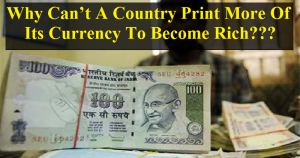
Why Can’t A Country Print More Of Its Currency To Become Rich?
It’s an interesting question to answer “Why can’t a country print the currency as much as needed to become rich?” Have you ever thought what stops Government from printing money? Can’t a country just print money and distribute that money to its citizens so that everyone lives a comfortable life? Here’s the answer.
Printing the currency notes is always backed up the level of production happening in a country and its ability to assign some value to its currency. The value of a currency depends on many factors e.g. net exports, Current and fiscal deficit, Interest rate in the economy among many moving parameters.

The main reason why countries don’t tend to print huge money is “INFLATION” (The value of currency reduces). When the inflation rate in the country goes to high, then Federal bank or the central bank (in India RBI) tends to increase the Interest rates, by which the money flow in the society decreases, results in the capability of buying the product decreases which decline in the inflation.
Let’s take a simplified example to understand this.
Suppose you have 100 kgs of gold and there are 10 people in your family. You now decide to distribute the gold among all the family members. However, instead of giving everyone 10 kg of physical gold, you give everyone a coupon that one could get 10 kg of gold in exchange for.
So 1 coupon = 10 kg of gold; 10 coupons = 10 x 10 kgs of gold. = 100 kgs of gold.
Now, each of those 10 members marries and bring a spouse into the family. Now, there are 20 members. However, the gold is still 100 kgs. In order to divide the gold equally among all members, you print 10 more coupons and hand them over to the new members of the family, while informing everyone that a coupon now can only be exchanged for 5 kgs of gold.
Therefore, after spouses come in: 1 coupon = 5 kg of gold; 20 coupons = 20 x 5 kgs of gold = 100 kgs of gold.
It should be obvious now that printing more coupons do not increase the value of the individual coupons because the ‘wealth’ of the family has not increased: it is still worth only 100 kgs of gold.
A country too functions in much the same way where the currency note functions as a coupon that has an inherent value. Printing more currency notes (coupons) will only reduce their inherent value in direct proportion to the number of additional currency notes printed.
The value of currency notes increases only when the ‘wealth’ of the country increases. This wealth is typically measured in GDP, GNP etc. The more wealth a country creates and accumulates, the more valuable its currency notes become.
Printing Money and National debt:
Governments borrow by selling government bonds / gilts to the private sector. Bonds are a form of saving. People buy government bonds because they assume a government bond is a safe investment. However, this assumes that inflation will remain low.
- If governments print money to pay off national debt, inflation would rise. This increase in inflation would reduce the value of bonds.
- If inflation increases, people will not want to hold bonds because their value is falling. Therefore, the government will find it difficult to sell bonds to finance the national debt. They will have to pay higher interest rates to attract investors.
- If the government print too much money and inflation gets out of hand, investors will not trust the government and it will be hard for the government to borrow anything at all.
Therefore, printing money will not make a country wealthy & could create more problems than it solves.